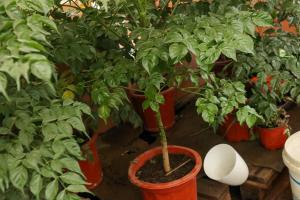What is Eating Holes in My Tomato Plant Leaves?
As a tomato plant owner, it's frustrating to find holes in the leaves - especially when it comes to the prized tomatoes that you've been nurturing for weeks. So what might be causing those holes? Let's investigate.
Possible Culprits
There are a few main suspects when it comes to tomato plant leaf-eaters:
Hornworms: These caterpillars grow up to 4 inches long and are green or brown. They have a horn-like protrusion on their hind end and voracious appetites for tomato plant leaves. Look for their tiny black droppings on the leaves.
Slugs and snails: These slimy creatures often come out at night and can cause significant damage to leaves, including holes and chewed edges. They leave behind shiny trails that give away their presence.
Aphids: These tiny insects suck the sap from tomato plant leaves, which can cause damage and lead to holes. They often congregate on the undersides of leaves and can be identified by their bright green or black color.
Prevention and Treatment
Prevention is always the best course of action when it comes to dealing with pests in your tomato plants. Here are a few tips:
Stay vigilant: Regularly inspect your tomato plants for signs of pest infestation, and take action before the problem worsens.
Use a protective barrier: Place a layer of diatomaceous earth around your tomato plants to deter slugs, snails, and other crawly creatures.
Introduce predator insects: Ladybugs, lacewings, and parasitic wasps are all natural predators of aphids and other pests, and can help to keep your tomato plants healthy and pest-free.
When it comes to treatment, there are a few options:
Hand-picking: While it might not be the most pleasant task, manually removing pests like hornworms and slugs from your tomato plants can be effective if caught early enough.
Use organic insecticides: There are several organic insecticides available that can help to treat pest infestations, such as neem oil and pyrethrin. Be sure to follow the instructions on the label carefully.
Seek professional help: If your pest problem becomes too severe, it might be time to call in a professional pest control service.
Conclusion
Don't let pests ruin your tomato crop! Stay vigilant, take preventative measures, and act quickly if you spot any signs of infestation. By doing so, you'll be able to enjoy healthy, bountiful tomato plants all season long.

 how many times do yo...
how many times do yo... how many planted tre...
how many planted tre... how many pine trees ...
how many pine trees ... how many pecan trees...
how many pecan trees... how many plants comp...
how many plants comp... how many plants can ...
how many plants can ... how many plants and ...
how many plants and ... how many pepper plan...
how many pepper plan...





























